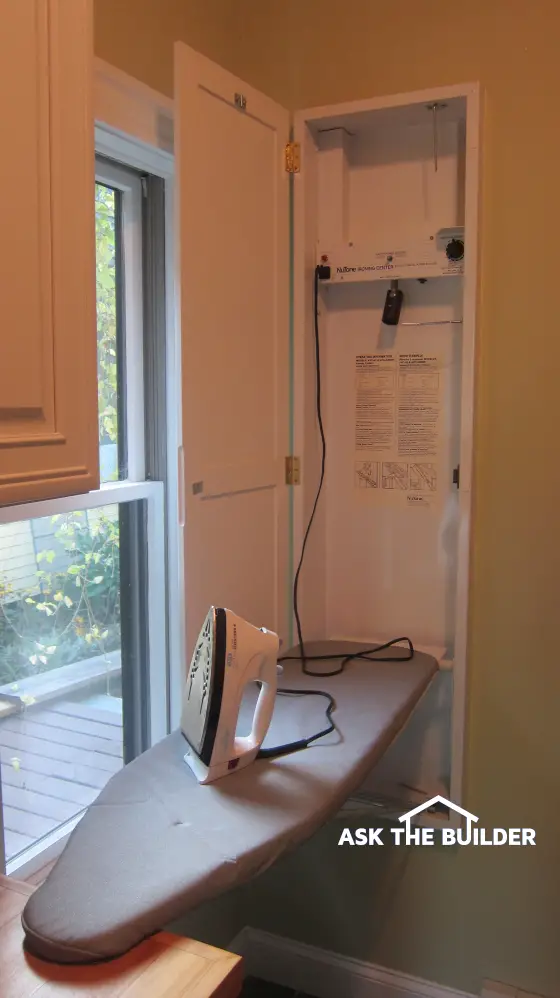How to Install a Wall-Mount Ironing Board

This ironing board was installed when the house was built. You can add one in a day to an existing house. Photo Credit: Tim Carter
Wall Mounted Ironing Board
DEAR TIM: My husband got transferred yet again and we're in another home in a new city. My last home had a wonderful wall-mounted ironing board. I loved how it stored away, including the iron! I have a slightly smaller laundry room in my new home and wonder if I can have one installed. Can you install one of these appliances on an exterior wall that has insulation in it? What are the obstacles you have to overcome when you install one in an existing home? Stacie G., Hartford, CT
DEAR STACIE: I don't envy the nomadic lifestyle that you're living. No doubt it's in your husband's best interests to keep you happy in your new abode. The good news is that you can get another wall-mount ironing board installed will minimal effort as long as you hire a professional or two.
There are several key obstacles that should be on your radar before you start this job. As you've already pointed out, the ironing board needs to be located in a spot where it can rotate out of its wall cabinet and not hit anything. You need to be able to stand next to the board and comfortably iron.
Look to make sure there are no wall cabinets or base cabinets that could interfere with the folding motion of the ironing board. In very tight situations, you can sometimes rotate the actual board slightly to bypass a wall cabinet that might otherwise prohibit the board from dropping down into the operating horizontal position.
Nearby base cabinets and countertops can interfere with the working height of the board. Once again, check to make sure the board would not hit a base cabinet or countertop when it's in the horizontal working position.
If you overcome these working barriers, the next toughest one is getting electricity to the ironing board. Most of the wall-mount ironing boards are equipped with lights and a power outlet for an iron that can be stored within the appliance.
The written instructions that come with your new ironing board should be followed to the letter. My guess is they'll undoubtedly suggest that you extend a new dedicated electrical circuit to the appliance. Irons can draw a significant amount of electricity and if you just extend a wire from an existing outlet or circuit, you could trip circuit breakers routinely as the iron operates.
Once you know you can get electricity to the appliance location, it's time to create the rough opening for the ironing board. The written instructions that come with the board will help you with the correct size. The metal cabinet that houses the board are made to fit in between 2 x 4 wall studs spaced at 16 inches on center. Most modern houses have this spacing.
After the opening is created in the wall, your electrician may find this giant hole a huge help in allowing him to get the needed electrical cable to the location. Horizontal fire blocking can be added after the hole is cut. The wood pieces can be stabilized with screws driven through the drywall. Toenail screws can then be driven at an angle into the wall studs using predrilled holes in the blocking pieces.
If you install the cabinet on an exterior wall that's framed with 2 x 4's, you'll discover that you'll have minimal insulation between the exterior sheathing and the back of the cabinet. You may discover that it's best to install pieces of closed-cell foam insulation in the gap between the back of the metal cabinet and the exterior sheathing.
You might think that this job will create all sorts of mess and disruption. Believe it or not, there's a possibility that you can do this entire job without having to do any drywall repair or repainting of your laundry room. It all depends on how hard it is to get the electrical cable to the needed location.
Better yet, if all aspects of the job are simple and no problems are encountered, it's possible for a carpenter and an electrician to have this job complete and be out of your driveway and headed to their next job in less than two hours. This is not a tough job to do. There are far tougher jobs that would cause significant disruption, dust, and overall misery.
To minimize surprises, be sure that you have the requisite spacing in between wall studs before you cut the hole. A carpenter with an electronic stud finder can determine this without cutting into the drywall.
If you run into problems with one particular wall-mount ironing board, look at other models. You may discover that a particular model made by a different manufacturer offers you more flexibility and options with respect to the conditions in your new laundry room.
Column 1004